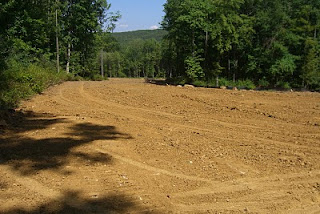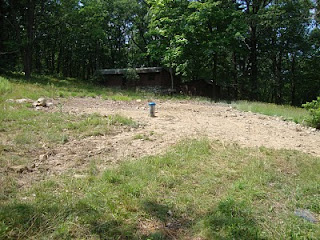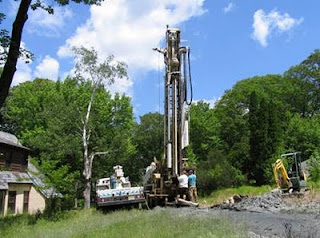Restoration of the South Branch Preserve, formerly the Rezamir Estates, in Mount Olive is progressing smoothly for its new owner, The Land Conservancy of New Jersey. We have completed the fourth week of construction, in the sixteen week long process. Construction is expected to be completed by September 30th, when the first phase (earth-moving work) of the South Branch Preserve Restoration Project will be done. The property was previously partially constructed for a 16-lot housing developement site which damaged and degraded the natural ecosystem. We are restoring the forest and streams so it fulfills its ecological potential and can once again protect the drinking water supply of the South Branch of the Raritan River and be available for public recreation.
Over the past two weeks, construction crews have been busy trying to meet the goals of our ambitious schedule and have been making significant progress. One of the two existing detention basins on the property has been filled in and the area graded. Three of six vernal ponds have been constructed in the basin's place. Vernal ponds occur when excess water drains into depressions and little pools of water develop during wet times of the year like spring. These ponds play a vital role in forest ecosystems; they are important habitat for amphibians and insects where they mate and lay their eggs. By mid-summer the ponds dry up for the most part, and the offspring leave the pond. Three more will be created after the remainder of this basin is filled in. Work has just begun on filling in the other detention basin with soil and quarry stone. For an explanation of the construction of vernal ponds onsite, please see the video below.
 One of the vernal ponds that has been constructed over the site of the former detention basin after a couple days of rain.
One of the vernal ponds that has been constructed over the site of the former detention basin after a couple days of rain.
Green frog eggs (the worm-shaped object) present in the new vernal pond after just 2 days.
A green frog in the new vernal pond.

In a little pond near one of the basins, dozens of frogs were gathered for mating.
Stream restoration work has also begun. At the stream junction, culverts were removed from under the road and the old cement arch bridge base is in the process of being jack-hammered and removed. The restoration crew, Paul W. Steinbeiser and company, has been working in conjunction with the Salmon construction group to pick up different sized boulders and rocks to use for the stream restoration project. They have also started grading the stream edges. For an explanation on the stream restoration process onsite, view the videos below.
 A jackhammer-like machine was placed on the backhoe to break apart a large cement pipe discovered within a culvert; see the video below.
A jackhammer-like machine was placed on the backhoe to break apart a large cement pipe discovered within a culvert; see the video below.
On July 6, the invasive plant species study began onsite. Invasive species are non-native plants that invade an area and disrupt the natural ecosystem. Michael van Clef, ecologist and President of Ecological Solutions Consulting Services based in Great Meadows, completed invasive species mapping in one area of the site last week and will finish the remainder of the study over the next week. A Plant Stewardship Index (PSI) was also conducted onsite by Bowman's Hill Wildflower Preserve. Although it's not quite complete, the PSI found that the property has one of the highest indices of native species diversity that they have seen in New Jersey! Plants noted in the PSI include trees, grasses, sedges, wildflowers, and shrubs.
 An approximately 100-year old tulip tree. If you look closely there's a little hole in the tree with a squirrel poking its head out.
An approximately 100-year old tulip tree. If you look closely there's a little hole in the tree with a squirrel poking its head out.Also on July 6, the fencing crew started the necessary field work to erect the fencing. Posts have been set up and next week the fencing will be hung. This fencing will keep deer off the restoration site, allowing the new plants, grasses, and shrubs that will be planted to grow undisturbed. The future visitors’ parking lot has been graded and staked out and some gravel has been spread out there.

This machine is used to stretch and hang the fencing.
The site is hardly recognizable only four weeks into construction and we are amazed by the progress. As we approach the completion date, keep checking the blog for updates.









 Stream crossing before restoration
Stream crossing before restoration  Reconstructed stream crossing
Reconstructed stream crossing







































 The new air handler located on the second floor.
The new air handler located on the second floor. The drill used to construct our well.
The drill used to construct our well. The construction crew installing piping 577 feet deep into the well.
The construction crew installing piping 577 feet deep into the well.
 Return pipe leading from basement furnace to the bottom of the well 577 feet below ground to re-circulate the water.
Return pipe leading from basement furnace to the bottom of the well 577 feet below ground to re-circulate the water.